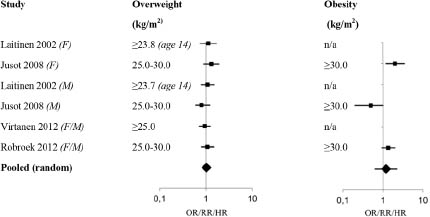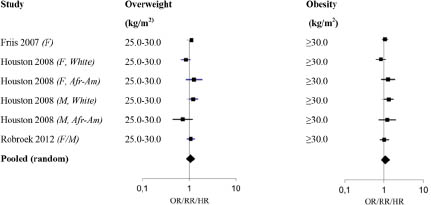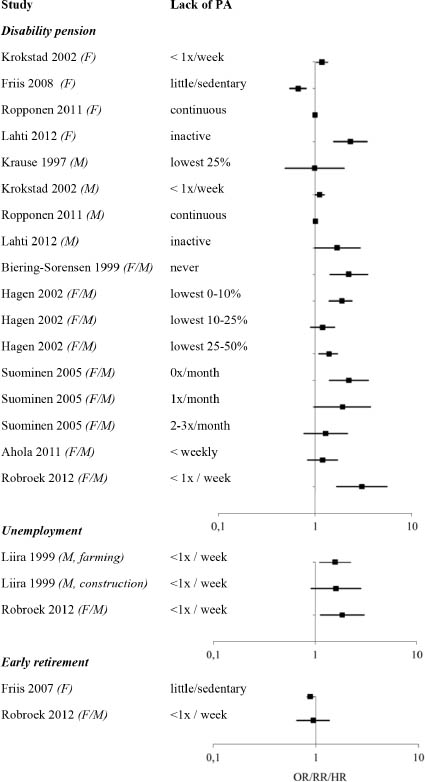Life expectancy is steadily increasing in developed countries. Governments are seeking to increase the proportion of elderly persons in paid employment by both extending working life through a higher official retirement age and preventing premature exit from paid employment. Therefore, many policies and programs are introduced to improve sustainable employability. In order to develop successful interventions to reduce premature exit from paid employment, insights into important modifiable risk factors for exit from paid employment are needed. From previous studies it is known that poor health is an important determinant of exit from paid employment, particularly due to disability pension (1). Furthermore, poor health has also been found to increase the likelihood of labor force exit into unemployment and early retirement (1). However, less is known about the role of important modifiable behavioral and social risk factors for poor health, especially lack of physical activity (PA) and obesity, in displacement from the labor force through disability pension, unemployment, and early retirement.
Recent studies have shown that a lack of PA and obesity are important risk factors for productivity loss at work (2), sickness absence (2), and reduced work ability (3). Numerous health promotion programs for a healthier lifestyle have been offered to employees. These programs are also often evaluated in terms of health and productivity. In recent years, several systematic reviews have been conducted that corroborate the influence of lifestyle-related factors, mainly obesity, on productivity loss at work (4–6), and sickness absence (5–8). However, there is less insight into the particular role of these factors on different routes of premature exit from paid employment.
A systematic review of 16 cross-sectional and longitudinal studies reported that a higher body mass index (BMI) was significantly associated with disability pension (9). The potential contribution of overweight, obesity, and lack of PA to unemployment and early retirement is less well known.
In order to understand and quantify the importance of these factors on different labor market exit pathways, the literature needs to be synthesized. Hence, we conducted a systematic review and meta-analysis. The aims were to (i) describe the influence of overweight, obesity, and lack of PA on exit from paid employment through disability pension, unemployment, and early retirement, and (ii) identify the influence of study population and study design on the magnitude of this association.
Methods
Identification of the studies
Relevant articles were identified by means of a computerized search in the bibliographic databases PubMed, Embase, and Web of Science up to 31 December 2012. The search terms were related to (i) a lack of PA or overweight/obesity, (ii) early retirement or unemployment or disability pension, and (iii) a longitudinal design. The detailed search for each bibliographic database can be found in Appendix A (www.sjweh.fi/data_repository.php). To be included, articles had to meet the following criteria: (i) describe the relationship between overweight, obesity, or lack of PA and exit from paid employment through early retirement, unemployment, or disability pension; (ii) study this relationship in a longitudinal design; (iii) express the strength of the relation in a quantitative measure or provide sufficient information to calculate a quantitative measure and corresponding confidence interval; and (iv) be written in English. Studies on specific patient populations were excluded from this review.
Selection
The first author performed the literature search and selected titles and abstracts. A broad selection of studies was used so that we could include studies in the screening that did not primarily focus on the risk factors overweight, obesity, or lack of PA, but rather included these factors as confounding factors. Subsequently, the second author selected the fulltext articles to be included in the meta-analysis. In case of doubt, the first author was consulted. Figure 1 shows the flow of the articles throughout the inclusion process. Based on title and abstract, 990 of 1097 articles (90%) were discarded because 818 abstracts (75%) did not describe exit from paid employment as an outcome, 156 abstracts (14%) did not study the role of lifestyle-related factors on exit from paid employment, and 16 abstracts (1%) did not describe a longitudinal study. In total, 107 articles were retrieved for full review of which 79 were excluded (74%) for various reasons (see figure 1). In case of duplicate use of data sets, the study providing the most complete information was chosen. Finally, 28 articles (3%) met our inclusion criteria.
Figure 1
Flow chart describing the article search process. *One study included unemployment, early retirement, and disability pension as outcome measures [Robroek et al (18)]
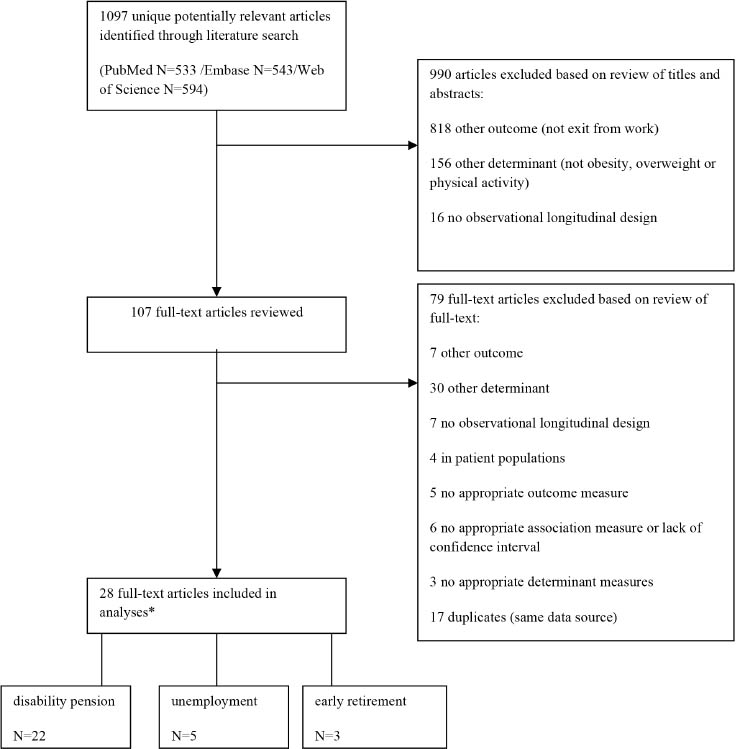
Data extraction
The first author extracted information on population characteristics (sex, age, country of study), study characteristics (number of participants, length of follow-up), occurrence of exit from paid employment and the magnitude of the association with corresponding confidence intervals. When more associations were presented within a study, the maximal adjusted association was chosen.
Quality evaluation
The methodological quality was assessed according to an abbreviated version of the Methodological Evaluation of Observational Research checklist (10). Criteria for quality assessment in this systematic review addressed four items on internal (response, subject flow) and external validity (adjustment for confounding factors, loss to follow-up), whereby each criterion was scored as 1 (sufficiently met), 0 (insufficiently met or lack of essential information). The contrast in measurements is restricted to objective or subjective measurement of determinants and outcomes since all included studies derived comparable information. Therefore, no additional information concerning measurement quality will be presented. The detailed information on quality aspects is presented in Appendix B (www.sjweh.fi/data_repository.php).
Data synthesis and data analysis
The first step in the meta-analysis was to estimate the pooled effects using an excel spread sheet for pooling of relative risks (11). Due to observed heterogeneity (heterogeneity statistics I2 >50% for disability pension) between studies, a random effects model was used in the meta-analysis on reported hazard ratios (HR), odds ratios (OR), and relative risks (RR). These measures of association were used interchangeably and interpreted as an expression of RR. Random-effects meta-analysis assumes that there are real differences between individual studies regarding the magnitude of the association between health determinants and exit from paid employment. It considers both between- and within-study variability (12).
The standard definitions for obesity (BMI≥30 kg/m2) and overweight (25≤BMI<30 kg/m2) will be used. For those studies that used other definitions (13, 14), BMI>27.5 kg/m2 was considered as obesity, and BMI>22.5 kg/m2 was considered to reflect overweight. In case BMI was presented as a continuous variable (15, 16), it was transformed to the corresponding categories with the assumption of a constant risk increment (17).
Subsequently, the influence of study and population characteristics on associations between obesity and overweight with exit from paid employment was analyzed by a stratified meta-analysis.
Results
In total, 28 longitudinal studies described the influence of BMI or lack of PA on disability pension (N=22), unemployment (N=5), or early retirement (N=3). One study provided associations with disability pension, unemployment, and early retirement (18). The study sizes varied between N=781 (19) and N=1 191 027 (20) and the median follow-up time was 10 years with a range of 2.5 (21) to 38 (20) years. Several studies presented more than one risk estimate, either through stratification (ie, gender), several cut-offs for the determinants, or numerous outcome measures. Therefore, the sum of associations presented for disability pension (obesity: N=29, overweight: N=23, lack of PA: N=17), early retirement (obesity: N=6, overweight: N=6, lack of PA: N=3), and unemployment (obesity: N=3, overweight: N=6, lack of PA: N=2) was >28 (Appendix C www.sjweh.fi/data_repository.php). Because of the few studies investigating the associations with early retirement or unemployment, the stratified meta-analysis of population and study characteristics is restricted to studies evaluating disability pension outcomes only. No pooled estimates were calculated for lack of PA due to the large variety in definitions and cut-off points used.
Disability pension
Fifteen (13, 15, 16, 18, 20–30) and 17 studies (13, 15, 16, 18, 20, 21, 23–33) investigated the influence of overweight (23 associations) and obesity (29 associations) on the risk of disability pension, respectively (see figure 2). In 15 of 23 associations, overweight was a statistically significant risk factor with an overall estimate across all 23 associations of RR=1.16 [95% confidence interval (95% CI) 1.08–1.24]. In 20 of 29 associations, obesity was also a statistically significant risk factor with a higher pooled estimate across 29 associations of RR=1.53 (95% CI 1.35–1.72). The stratified meta-analysis shows stronger associations for obesity in Scandinavian (RR=1.57, 95% CI 1.39–1.78) than non-Scandinavian studies (RR=1.21, 95% CI 0.81–1.81). There were no differences in associations between studies performed among women (RR=1.53, 95% CI 1.27–1.86) or men (RR=1.56, 95% CI 1.29–1.87). Studies with a longer follow-up time showed slightly higher RR (follow-up period ≥10 years: RR=1.57, 95% CI 1.36–1.81; follow-up period <10 years: RR=1.44, 95% CI 1.32–1.58). The more recently a study was published, the more likely they reported a lower association estimate (published in/after 2002: RR=1.44, 95% CI 1.25–1.66; published before 2002: RR=1.85, 95% CI 1.51–2.26). Concerning quality characteristics, there were no major differences in risk estimates between studies with a response level < or >30% or studies that did or did not adjust for other lifestyle factors. Studies with objective information (RR=1.67, 95% CI 1.44–1.94) on obesity were more likely to report a stronger association estimate than those based on self-reported information (RR=1.30, 95% CI 1.19–1.43). Studies lacking information about the flow of subjects were, although not statistically significant, more likely to report a stronger association between obesity and disability pension (RR=1.64, 95% CI 1.35–1.99 versus RR=1.46, 95% CI 1.24–1.71).
Figure 2
Association between obesity, overweight and disability pension. Body mass index as a continuous variable was transformed to the corresponding categories with the assumption of a constant risk increment.
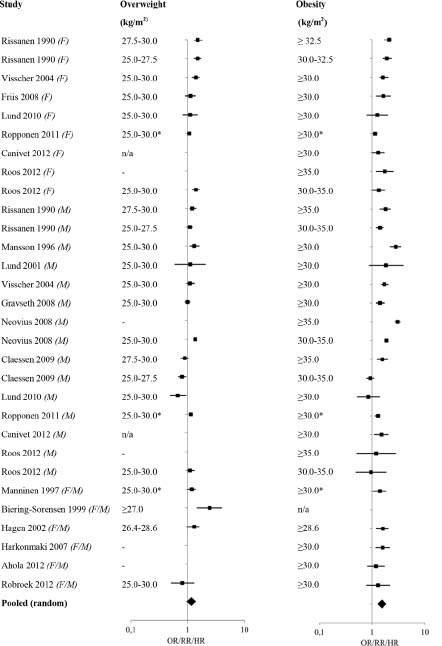
Ten studies (13, 16, 18, 22, 24, 31, 34–37) investigated the influence of lack of PA during leisure time on the risk of disability pension, presenting 17 associations (figure 5). In 8 of these associations, lack of PA was a statistically significant risk factor for disability pension. With the exception of one study (24), all presented a RR>1 for the association between lack of PA and disability pension.
Unemployment
Four (14, 18, 38, 39) and two studies (18, 38) investigated the influence of overweight (6 associations, none statistically significant) and obesity (3 associations, 1 statistically significant) on unemployment, respectively (see figure 3). After pooling, no statistically significant associations were found between obesity (pooled RR=1.20, 95% CI 0.64–2.25) or overweight (pooled RR=1.02, 95% CI 0.90–1.16, figure 3) and unemployment. Two studies (18, 19) investigated the influence of lack of PA during leisure time on unemployment presenting three associations (figure 5). Two of these associations presented a statistically significant increased risk of lack of PA on unemployment (figure 5).
Early retirement
Three studies (18, 40, 41) investigated the influence of overweight or obesity on early retirement presenting six associations (see figure 4). One of these associations presented an increased risk of early retirement among obese individuals, but no statistically significant association was found when all six studies were pooled (pooled RR=1.07, 95% CI 0.95–1.20, figure 4). Two of six associations presented a statistically significant increased risk of early retirement among overweight individuals, but again no statistically significant association was found when all the studies were pooled (pooled RR=1.08, 95% CI 0.95–1.23, figure 4). The two studies investigating the association between lack of PA and early retirement reported no statistically significant increased risk of early retirement (18, 40).
Discussion
This meta-analysis provides insight into the role of overweight, obesity, and lack of PA during leisure time on premature exit from paid employment. Obese – and to a lesser extent overweight – workers had an increased likelihood of exit from paid employment through disability pension among both men and women, but obesity was not a risk factor for unemployment or early retirement. Workers with lack of PA had an increased risk of disability pension and unemployment, but not of early retirement.
The finding that obesity, and to a smaller extent overweight, are related to future disability pension confirms the results of a previous systematic review on eight longitudinal studies (9). The majority of the studies included in the current review consistently reported a statistically significant association between obesity and disability pension in spite of different definitions for both risk factor and outcome. Interestingly, in several studies, a lack of PA during leisure time was also a significant risk factor for disability pension. However, the available evidence in longitudinal studies suggests that obesity is more important than PA for sustained employability. Since the majority of the studies did not report information concerning the underlying reason for disability pension, we were not able to disentangle whether the relation between obesity and lack of PA with disability pension is mediated by specific diseases.
The increased risk of disability pension among obese workers is in line with the findings of recent studies on the relation between obesity on one hand and productivity loss at work and sick leave on the other hand (4–8, 42). The results imply that the increasing prevalence of obesity in most Western countries is a concern with regard to work participation and sustainable employability. A healthy lifestyle and body weight are important for a productive workforce.
Three studies were included that reported on the association between obesity and unemployment and early retirement. The pooled estimate was weak and non-significant, suggesting that obesity plays a minor role in displacement from the labor market through both pathways. In general, these pathways are to a lesser extent driven by health problems (1). Other financial or social factors might play a more important role in these pathways of exit from work than might be the case when leaving the labor market through a specific health-related pathway such as disability pension (43).
Few studies investigated the relationship between a lack of PA and exit from work. Only two studies evaluated the role of lack of PA on early retirement and unemployment. For both disability pension and unemployment, several studies found lack of PA to be a risk factor. Other lifestyle-related factors, such as smoking or an unhealthy diet, were not evaluated in this meta-analysis. Several studies have shown that such lifestyle factors, particularly smoking, may play a role in premature exit from paid employment, especially through disability pension (18, 38). Promoting a healthy lifestyle might thus be a way to prevent workers from leaving the workforce too early. Interventions could range from organizational workplace changes that enhance the ability of employees to engage in PA [eg, flexible working conditions (44)] to workplace health promotion and onsite PA and healthy eating initiatives (45). Most intervention studies on workplace health programs have follow-up periods of at best 24 months, which is far too short to demonstrate a noticeable impact on work participation. In order to gain more insight into the role of lifestyle on sustained labor participation, studies with repeated measurements during longer follow-up periods are needed.
Socioeconomic status is a potential confounder for the relation between lifestyle-related factors and exit from work. From previous studies, it is known that an unhealthy lifestyle and obesity are more prevalent among individuals in lower socioeconomic groups (46). Furthermore, individuals with a lower education or in a lower occupational class are more likely to leave the labor force due to disability pension, unemployment, or early retirement (1, 47). However, in the stratified meta-analysis no systematic lower risk of exit from paid employment was observed between studies adjusting for socioeconomic status, educational level, or job type and studies that did not adjust for these factors. A potential explanation might be that the response in questionnaire surveys is typically higher among higher educated employees and, thus, study populations reflect better higher-educated populations.
A strength of this systematic review is the availability of various studies on disability pension, which supported an informative meta-analysis. In contrast, only few studies evaluated the role of obesity and lack of PA on early retirement and unemployment. There are also some limitations in this systematic review. First, the literature search was limited to three electronic databases and English publications. Therefore, it is possible that we still missed some useful studies. Second, there is substantial variation among studies concerning definitions for determinants (particularly for lack of PA) and outcomes, the follow-up period, and the study populations. With the exception of three studies (18, 21, 33), all used register-based outcome data. We found that the method of measurement of determinant (self-report or objective measurement) did influence the pooled estimate. Studies based on objective information to define BMI were more likely to find a stronger association with disability pension. A possible explanation might be that weight is underreported in studies using self-reported information. Since the heterogeneity in definitions was limited, we decided to pool the studies investigating overweight and/or obesity in spite of heterogeneity. Third, the majority of studies are from Scandinavian countries, hampering the generalizability of findings to other countries. The stratified meta-analysis shows stronger associations between obesity and the risk of disability pension among obese individuals in Scandinavian compared with non-Scandinavian countries. This prompts a need for studies in other countries to corroborate or refute the association between obesity and disability pension. Last, although publication bias cannot be ruled out, there was no relation between the magnitude of risk estimates and their standard errors.
After summarizing the literature, it can be concluded that obesity is a risk factor for exit from paid employment through disability pension, but there is no evidence of a relationship with other routes of exit from work. There are also indications that a lack of PA during leisure time was related to an increased risk of disability pension and unemployment. Although our meta-analysis is unable to identify the mechanisms through which obesity, overweight, and lack of PA contribute to labor market exit, it strongly suggests that – in order to maintain a productive and healthy workforce and protect workers against premature exit from paid employment – the implementation of long-term interventions and policies to promote PA and prevent overweight and obesity be considered.


